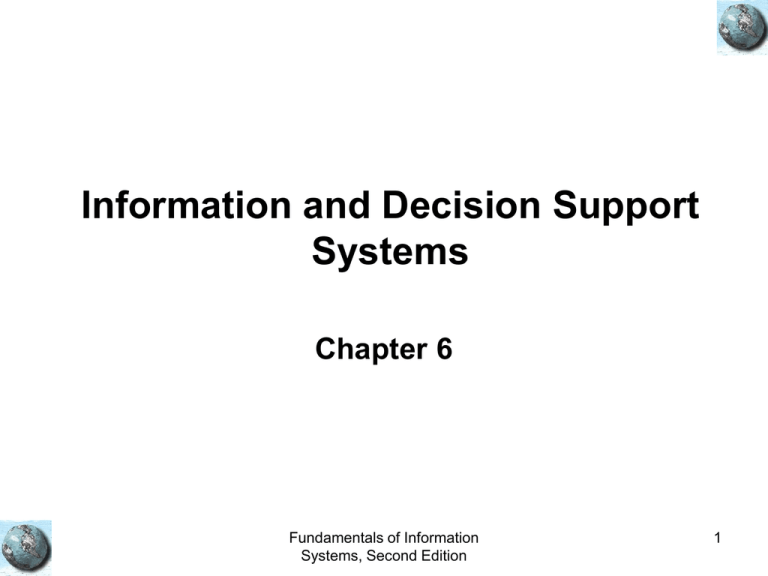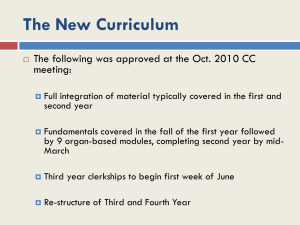ss - Noppa
advertisement

Information and Decision Support Systems Chapter 6 Fundamentals of Information Systems, Second Edition 1 Principles and Learning Objectives • Good decision-making and problem-solving skills are the key to developing effective information and decision support systems. – Define the stages of decision making. – Discuss the importance of implementation and monitoring in problem solving. Fundamentals of Information Systems, Second Edition 2 Principles and Learning Objectives • The management information system (MIS) must provide the right information to the right person in the right fashion at the right time. – Define the term MIS and clearly distinguish the difference between a TPS and an MIS. – Discuss information systems in the functional areas of business organizations. Fundamentals of Information Systems, Second Edition 3 Principles and Learning Objectives • Decision support systems (DSSs) are used when the problems are more unstructured. – List and discuss important characteristics of DSSs that give them the potential to be effective management support tools. – Identify and describe the basic components of a DSS. Fundamentals of Information Systems, Second Edition 4 Principles and Learning Objectives • Specialized support systems, such as group decision support systems (GDSSs) and executive support systems (ESSs), use the overall approach of a DSS in situations such as group and executive decision making. – State the goals of a GDSS and identify the characteristics that distinguish it from a DSS. – Identify the fundamental uses of an ESS and list the characteristics of such a system. Fundamentals of Information Systems, Second Edition 5 Decision Making and Problem Solving Fundamentals of Information Systems, Second Edition 6 How Decision Making Relates to Problem Solving Fundamentals of Information Systems, Second Edition 7 Programmed versus Nonprogrammed Decisions • Programmed decisions – Easy to computerize • Nonprogrammed decisions – Rules and relationships not defined – Problem is not routine – Not easily quantifiable Fundamentals of Information Systems, Second Edition 8 Problem Solving Approaches • Optimization: find the best solution • Satisficing: find a good solution • Heuristics: rules of thumb Fundamentals of Information Systems, Second Edition 9 Optimization, Satisficing, and Heuristic Approaches Fundamentals of Information Systems, Second Edition 10 An Overview of Management Information Systems Fundamentals of Information Systems, Second Edition 11 Sources of Managerial Information Fundamentals of Information Systems, Second Edition 12 Reports Generated by an MIS Fundamentals of Information Systems, Second Edition 13 Reports Generated by an MIS Fundamentals of Information Systems, Second Edition 14 Guidelines for Developing MIS Reports Fundamentals of Information Systems, Second Edition 15 Functional Aspects of the MIS Fundamentals of Information Systems, Second Edition 16 Functional Aspects of MIS Fundamentals of Information Systems, Second Edition 17 Overview of a Financial MIS Fundamentals of Information Systems, Second Edition 18 Manufacturing MIS • Material requirements planning (MRP) • Manufacturing resource planning (MRPII) • Just in time (JIT) inventory system Fundamentals of Information Systems, Second Edition 19 Overview of a Manufacturing MIS Fundamentals of Information Systems, Second Edition 20 Overview of a Marketing MIS Fundamentals of Information Systems, Second Edition 21 Human Resource MIS Concerned with activities related to employees and potential employees of the organization. • Subsystems include: – – – – – needs and planning assessments recruiting training and skills development scheduling and assignment employee benefits Fundamentals of Information Systems, Second Edition 22 Overview of a Human Resource MIS Fundamentals of Information Systems, Second Edition 23 Other Management Information Systems • Accounting MIS - provides aggregate information on accounts payable, accounts receivable, payroll, and many other applications. • Geographic Information Systems - computer system capable of assembling, storing, manipulating, and displaying geographic information. Fundamentals of Information Systems, Second Edition 24 An Overview of Decision Support Systems Fundamentals of Information Systems, Second Edition 25 Capabilities of a Decision Support System • Support for problem-solving phases • Support for different decision frequencies • Support for different problem structures • Support for various decision-making levels Fundamentals of Information Systems, Second Edition 26 Selected DSS Applications Fundamentals of Information Systems, Second Edition 27 Support for Various Decision-Making Levels Fundamentals of Information Systems, Second Edition 28 Comparison of DSSs and MISs Fundamentals of Information Systems, Second Edition 29 Components of a DSS Fundamentals of Information Systems, Second Edition 30 Conceptual Model of a DSS Fundamentals of Information Systems, Second Edition 31 The Model Base Fundamentals of Information Systems, Second Edition 32 Group Decision Support Systems Fundamentals of Information Systems, Second Edition 33 Configuration of a DSS Fundamentals of Information Systems, Second Edition 34 Characteristics of a GDSS • • • • • • • • Special design Ease of use Flexibility Decision-making support Anonymous input Reduction of negative group behavior Parallel communication Automated record keeping Fundamentals of Information Systems, Second Edition 35 GDSS Alternatives Fundamentals of Information Systems, Second Edition 36 The GDSS Decision Room Fundamentals of Information Systems, Second Edition 37 Executive Support Systems Fundamentals of Information Systems, Second Edition 38 The Layers of Executive Decision Making Fundamentals of Information Systems, Second Edition 39 Executive Support Systems (ESS) in Perspective • • • • • • • Tailored to individual executives Easy to use Drill down capabilities Support need for external data Can help when uncertainty is high Future-oriented Linked to value-added processes Fundamentals of Information Systems, Second Edition 40 Capabilities of an ESS • • • • • Support for defining an overall vision Support for strategic planning Support for strategic organizing & staffing Support for strategic control Support for crisis management Fundamentals of Information Systems, Second Edition 41 Summary • Decision-making phase - includes intelligence, design, and choice • Problem solving - also includes implementation and monitoring • Decision approaches - optimization, satisficing, and heuristic • Management information system - an integrated collection of people, procedures, databases, and devices that provide managers and decision makers with information to help achieve organizational goals Fundamentals of Information Systems, Second Edition 42 Summary • Decision support system (DSS) - an organized collection of people, procedures, software, databases, and devices working to support managerial decision making • Group decision support system (GDSS) - also called a computerized collaborative work system, consists of most of the elements in a DSS, plus software needed to provide effective support in group decision-making settings • Executive support systems (ESSs) - specialized decision support systems designed to meet the needs of senior management Fundamentals of Information Systems, Second Edition 43








